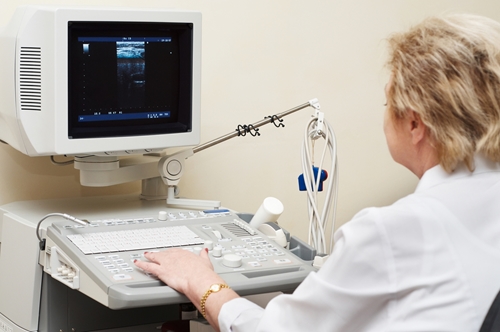According to a medical-imaging study published in Nature Communications noninvasive ultrasound technology could give neuroscientists the power to probe neurons and prompt neural reactions.
Researchers from the Stalk Institute for Biological Studies and the University of California, San Diego were able to trigger neural reactions inside microscopic roundworms using an ultrasound machine. The scientists altered the chemical makeup of specific neurons within these worm by introducing TRP-4, an ultrasound-sensitive protein, via a virus. Once modified, the neurons responded to the ultrasound and were engineered to glow when activated. They then placed the worms in a fluid filled with microscopic bubbles meant to amplify the waves. When exposed to the ultrasound device, the neurons reacted and fluoresced. The worms wriggled.
The researchers named this technique sonogenetics. Dr. Sreekanth Chalasani, the chief researcher for the sonogenetics study, believes that diagnosticians and neuroscientists will soon be able to use this technique on human patients.
"We believe that, using gene therapy and a therapeutic virus, it may be possible to make target human neurons temporarily susceptible to the ultrasound signal in a clinical setting for certain neurological treatments," Chalasani said in an interview with The Guardian.
A Possible Alternative To Optogenetics
The current method for studying and altering neural activity is called optogenetics. According to The New Yorker, this process "renders individual, highly specific brain cells photosensitive and then activates those cells using flashes of light delivered through a fiber optic wire." Though effective, optogenetics is fairly invasive, as it requires the implantation of a cable that facilitates a connection between the brain and light waves, reported The New York Times.
After this device is implanted, neuroscientists can control a patient's neurons by regulating the amount of light the device emits via a web-based application. This enables therapists to treat individuals for mood disorders and other neurological conditions. According to a study published in "Nature," neuroscientists can even use optogenetic techniques to engineer memory.
Conversely, sonogenetics is completely noninvasive, as ultrasound waves, unlike light waves, can easily penetrate body tissue without a conduit.
"Ultrasound is perfect because it goes through the skin, is not scattered, and maintains energy when it penetrates the skin," Chalasani said during an interview with Motherboard. "You could imagine sticking an ultrasound cap on someone's head and using that to switch neurons on and off non-invasively."
Future Treatment Possibilities
According to Chalasani, sonogenetics might someday replace invasive neural treatments like deep-brain scanning, which is used to study and treat Parkinson's disease patients. Arizona State University neuroscientist William Tyler agreed and told The Times that sonogenetics is "going to become a viable technique."
Despite the emergence of sonogenetics, optogenetics is here to stay, reported Motherboard. Chalasani admitted to Motherboard that optogenetics was faster, as light travels faster than sound.
"The ion channels that respond to light are working much faster than the channels responding to ultrasound," he told the publication. "If you're working on the cortex of a human brain, working on a scale of a tenth of a second, optogenetics is going to do better. I think these will be complementary techniques."
Ronny Bachrach
Latest posts by Ronny Bachrach (see all)
- Konica Minolta Debuts First-of-Its-Kind Digital U-Arm System at AHRA - July 27, 2016
- Researchers Detect Signs Of Stroke Risk Using MRI - June 27, 2016
- Imaging Biz: Q&A with David S. Channin MD: How to Make PACS Patient Centered - June 22, 2016










